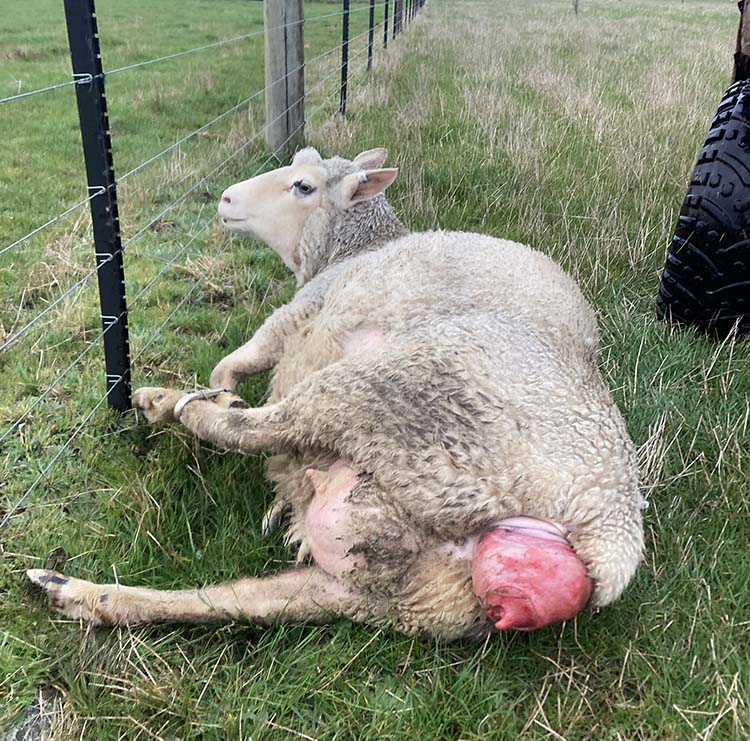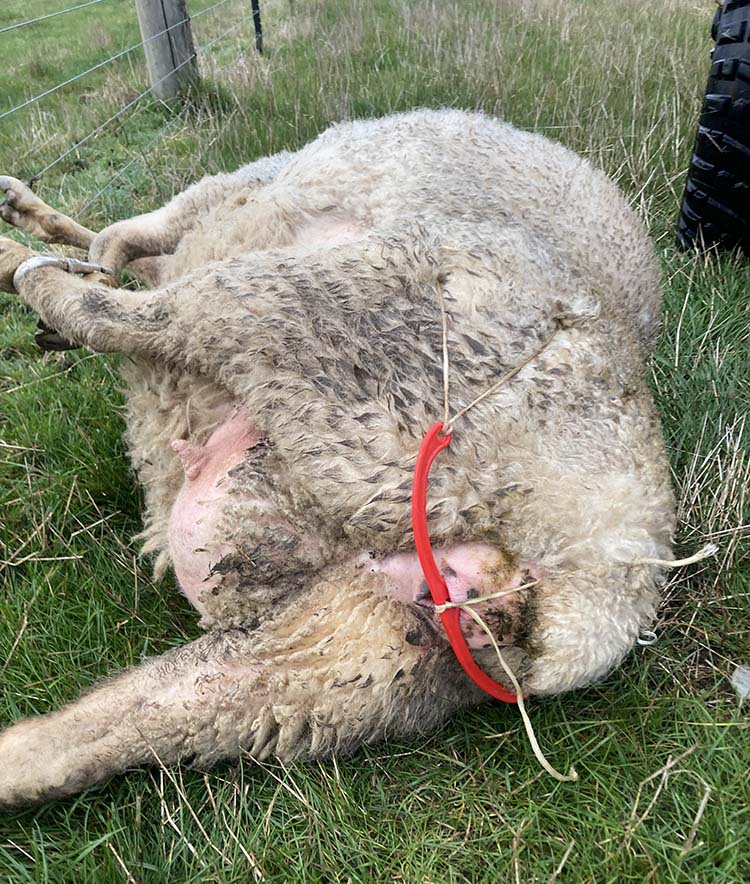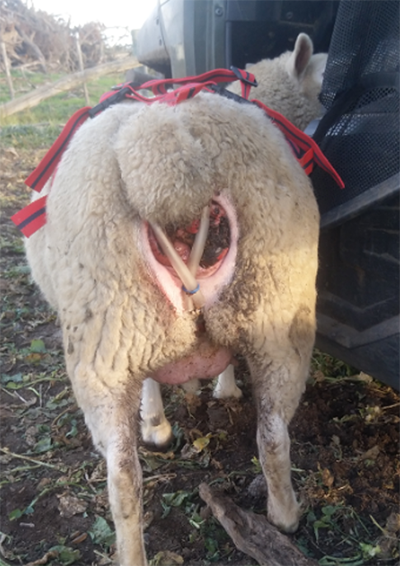The prolapsing ewe
Author:Dr Cathy Bunter – District Veterinary Officer, Agriculture Victoria
Prolapses in ewes (vaginal and uterine) occur at varying frequency but can be costly in ewe and lamb deaths so this article looks at the possible causes and preventative measures.
Vaginal prolapse
Occurring most commonly in the last month of pregnancy, this is where the ewe pushes her vagina out of her vulva. The prolapsed vagina appears as a smooth red mass varying from tennis ball to melon size. The ewe may separate herself from the mob and because of the pressure around her vulva many ewes become confused and try to steal other lambs, thinking they have already lambed themselves.
During the last trimester of pregnancy, the ewe’s oestrogen levels rise, and they produce a hormone called relaxin which relaxes the pelvic ligaments and surrounding soft tissues. Increased abdominal pressure caused by the pregnant uterus combined with this soft tissue relaxation is the main predisposing factor.
Causes/Predisposing Factors
There are many factors that may contribute to an increased likelihood of vaginal prolapses and these include:
- Genetic predisposition – higher prevalence in crossbred ewes and prolapse is heritable.
- Age – older ewes who have lambed before however ewe lambs also seem to be affected by vaginal prolapses.
- Over-fat ewes – over-fat ewes are likely to have higher levels of intrabdominal fat and more fat in the vaginal wall. The increased pressure in the area particularly as the weight of the developing lamb increases causes pressure on the already heavy vagina.
- Multiple lambs – equals more weight in the area and the increasing pressure on the vagina.
- Lameness/increased time lying down – longer periods of recumbency results in increased pressure on the enlarging uterus and vagina.
- Little exercise – results in less muscle tone and increased pressure on abdominal structures due to increased time sitting.
- Diet – oestrogenic clovers/other oestrogenic feed consumed may cause swelling of the vagina and relaxation of the pelvic ligaments. Bulky diets may also contribute to increased ruminal size.
- Low blood calcium (hypocalcaemia) – calcium is required for the normal functioning of muscles. Low calcium levels result in weakness and low muscle tone.
- Tail length – tails which are docked too close to the ewe’s body result in contraction of the lower end of the spinal cord and decreased nerve control to all the structures (rectum, bladder and vulva-vagina) around the base of the tail. This results in decreased feeling and less tone in these structures.

Management options/Treatment
Treatment options for vaginal prolapses depend on the size of the prolapse, but the one thing they all have in common is that treatment should be commenced as soon as possible to prevent further damage to the surface of the vagina. If the vaginal prolapse is only small and keeps self-lubricating itself by replacing itself back in the right position through the vulval opening, then it may not need treatment. This type of prolapse still requires ongoing close observation. If the vaginal prolapse is of bigger dimensions and the mass hangs out of the vulva for prolonged periods of time, then the blood flow to the vagina can become damaged with the prolapse turning blue/black and the surface becomes dry and very easily damaged and ulcerated. The prolapse can also become fly struck.
Ideally, the ewe should be treated by a veterinary surgeon as they have the correct medications and techniques to prevent the ewe from straining while the vaginal prolapse is replaced. If this is not possible then treatment of a vaginal prolapse involves gently cleaning with warm clean water (+/- a mild non-irritating disinfectant) to remove any debris, if fresh, small, and not damaged, cover with either obstetrical or a water-based lubricant and apply gentle pressure on it to replace it back through the vulva. First check the prolapse for significant damage or any sign that the ewe has started to lamb (cervix open, lamb head/legs palpable, waterbag protruding) and seek veterinarian advice before proceeding.
The urinary bladder may get flipped up inside the prolapse, blocking the bladder outlet, so you can gently lift the prolapse up towards the tail and this may allow the ewe to urinate and reduce the size of the prolapse. If there are signs that the sheep’s intestines have herniated through a tear in the vagina, then humanely euthanise as soon as possible.
The ewe will most likely strain against you, so keeping the vaginal prolapse in, is more difficult. A number of treatments are used by farmers with varying success but if in doubt the best option is to speak to your veterinarian about treatment before proceeding.
- Harnesses which apply pressure around the edges of the vulva to stop the prolapse from popping out again. It is important to fit the harness correctly and check them regularly. As lambing time approaches, they should be loosened or totally removed.
- Spoon/T piece retainer. This is secured to the ewe using string or tape and has a T shaped implement which applies pressure into the vagina to stop it from popping out. The ewe can lamb past the device, but it should be removed at lambing time.
- Suture placement – Buhner/purse-string suture. These must only be placed using local anaesthetic by a registered veterinary surgeon. As lambing time approaches the suture must be loosened or completely removed.
- Appropriate antibiotics and anti-inflammatories/pain relief administered in consultation with your veterinarian.


Prevention
To reduce the prevalence or likelihood of vaginal prolapses, management options include:
- Cull affected ewes from the mob. If possible, also cull the ewe lambs from these ewes, as vaginal prolapses are heritable.
- Manage age profile of breeding ewes.
- Appropriate nutrition: Manage to avoid over-fat ewes at lambing. Avoid high bulk diets especially in the final month of pregnancy. Provide appropriate nutrition for ewes carrying multiple lambs. Address nutritional deficiencies of calcium in your mob by supplying calcium licks, as appropriate.
- Avoid ewes grazing oestrogenic pastures. Phytoestrogens can be found in lucerne, clovers/sub clovers. High oestrogen subclovers still persist in many pastures across southern Australia. If in doubt, pastures can be tested for oestrogen content.
- Treat lame ewes in a timely manner.
- Tail dock at the appropriate length. Tails should be long enough to cover the tip of the vulva (below the third joint space) which ensures nerve damage is minimal and reduces the likelihood of vulval cancer.

Occurring shortly after lambing, the ewe’s uterus is pushed to varying degrees out through the open cervix and protrudes through the vulva. The size of the uterine prolapse varies from partial to complete with the mass of the uterus hanging below the ewe’s hocks. The prolapsed uterus appears as a large mass hanging from the vulva. The surface of the everted uterus appears bloody and has large numbers of round or oval shaped, mushroom-like lumps called “caruncles” on its surface. (These “caruncles” are lumps of uterine tissue which connect with “cotyledons” on the foetal placenta).
Uterine prolapse
Causes/Predisposing factors
The uterine prolapse generally occurs as a result of prolonged dystocia/lambing difficulty, excessive traction applied when pulling a lamb, invagination/eversion of the uterus and/or recumbency after lambing with the hindlimbs lying lower than the forelimbs. Hypocalcaemia and oestrogenic feeds also have an impact on the occurrence of uterine prolapse.
Management options/Treatment
Uterine prolapses should ideally be treated by a veterinarian as soon as possible, under appropriate medications and techniques. Unless the uterus is correctly replaced to its normal position within the abdomen the ewe will continue to strain and re-prolapse. The ewe’s prognosis depends on the amount of damage and contamination of the uterus and the longer the uterus is exposed the worse the prognosis becomes. The uterus needs to be kept as clean as possible and the ewe restrained while waiting for veterinary assistance.
If there are signs that the sheep’s intestines have herniated through a tear in the vagina, then humanely euthanise as soon as possible.
Prevention
While it is impossible to completely prevent uterine prolapses, there are a few management tips which will make their occurrence less severe. Careful observation of lambing ewes will enable early recognition of ewes having lambing difficulties and early intervention so that the lambing process is not prolonged. Be careful not to apply excessive traction when pulling lambs from the birth canal. Also, position the lambing ewe so that she is lying either on flat ground or with her hindquarters elevated. Careful observation also allows the provision of immediate assistance when a uterine prolapse occurs in terms of keeping the uterus clean and protected from damage as much as possible and calling for veterinary help as soon as possible.
Avoid grazing oestrogenic pastures and supply calcium pre-lambing if required.
For further information or advice please contact your private veterinarian or your local Agriculture Victoria District Veterinary Officer on 136 186
References
The Merck Veterinary Manual 11th Edition “Vaginal & Cervical Prolapse” and “Uterine Prolapse and Eversion”
Veterinary Medicine: A Textbook of the Diseases of Cattle, Horses, Sheep, Pigs and Goats. Radostits et al 10th edition (2007)
MLA : Veterinary Handbook Disease Finder “Prolapse of the Vagina”